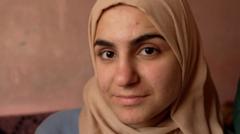Amidst the remnants of destruction, a sense of hope thrives in Homs, Syria, once dubbed the "capital of the revolution." Now at 20 years old, university student Baraa recalls the horrors her family endured during the war, reflecting on her tumultuous childhood spent fleeing conflict and managing on scarce resources. During a recent celebratory gathering at the end of Bashar al-Assad's long rule, Baraa, her sisters at her side, expressed optimism about the future, a stark contrast to the darkness of their past.
"Even now, I look back and wonder how we survived this nightmare," Baraa quietly reflects, her youthful resilience shining through her traumatic experiences. She recounts surviving a years-long siege that forced residents of Old City Homs to scavenge for food, living in fear as the regime employed cruel tactics to subdue civilians.
Her father, Farhan Abdul Ghani, voiced the sentiments of many families affected by the war, stating, "We did not want war. We did not want a forever president who builds monuments to himself." The scars of the past remain vivid, as Farhan lost his wife to a rocket strike during the conflict. Nevertheless, he proudly describes how life in Homs is slowly improving, with prices falling and markets regaining their vibrancy, a clear signal that peace might be returning to the region.
Dr. Hayan al-Abrash, a local physician, serves as a poignant reminder of the lingering pain from the past, having lost a brother to the torture cells of Saydnaya prison. As he navigates the remnants of a makeshift hospital he operated during the siege, he expresses a yearning for justice while emphasizing the urgency to rebuild a Syria free from tyranny. “We don’t forgive. It’s impossible for us,” he admits, highlighting the struggle for reconciliation amidst unresolved grievances.
The spirit of cooperation among Homs's diverse religious communities emerges as a beacon of hope. Conversations reveal a shared commitment to rebuild together, despite the haunting memories of destruction. Local clergy, such as Father Tony Homsy, underline the necessity of healing, stressing, “It will take time to heal our wounds, to heal our memories.”
As the winter chill envelops the city, a wave of optimism sweeps through its streets. Baraa dreams of completing her studies and impacting her community positively, embodying the changing tides in a city where countless residents continue to seek solace and future aspirations behind the shadows of their past. “I am dreaming of so many things now,” Baraa declares, symbolizing the burgeoning spirit of resilience that is taking root in what remains of Homs.



















